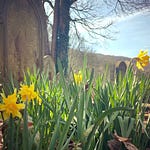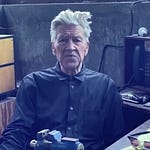‘Mind and consciousness is not what we have but what we are… Our existence on the physical plane of life is part of a vibrational spectrum of multi-dimensional consciousness extending far beyond space time.’ Dr Jude Currivan
Read on or listen to the audio to learn about -
A lost Persian manuscript that shows how the ancients viewed science & spirituality as one.
Carl Jung’s theory of the collective unconscious & his experiments with mandalas.
What ants can teach us.
Expand your sense of possibility with the depth-writing prompts at the end of this essay.
Join a depth-writing workshop on Monday July 22nd, 7pm - 8.15pm GMT, to do this month’s prompts in a friendly, supportive online space.
Book here (Free to paid subscribers)
Artwork: Manuscript page from The Offering to the Emperor: Circles of the Sciences and Tables of Numbers compiled by Mirza Muhammad al-Akhbārī
A meeting with the past
On a blustery, overcast day in Lisbon I found myself travelling back in time through the mottled pages of a faded manuscript filled with Arabic calligraphy and intricate line drawings in red, black and gold ink to nineteenth century Iran. Compiled by the Persian scholar Mirza Muhammad al-Akhbārī and entitled The Offering to the Emperor: Circles of the Sciences and Tables of Numbers, the manuscript had been dug up from the vaults of the Gulbenkian Institute, where I happened to be visiting, and put on public display for the very first time.
As I studied the manuscript’s diagrams showing the heavens, earth and human soul as a radial system of concentric circles, alongside the signs of the zodiac, tables of holistic medicines and lists of measures for locating cities and stars, I was transported back again to first century Arabia and a time when science and spirituality were viewed as one.
Nor did my time-travel stop there. On reading about the history of The Offering to the Emperor, I was swept further back to the deep once-upon-a-time of the manuscript’s origin in the mythic story of an encounter between King Solomon and a Queen Ant on the fertile plains of ancient Israel. According to this tale, (various versions of which can be found in the Quran, Talmud and Bible) on seeing the stampede of King Solomon and his army coming over the horizon and fearing her colony was about to be crushed, the Queen Ant cried out in fear of her life. But when King Solomon heard her shriek above the thunder of hooves, he re-routed his men, saving the colony. In gratitude, the Queen Ant gifted him the secrets of the cosmos. And this, so it’s said, is where the circles of the sciences and tables of numbers illustrated in the manuscript - whose wavering, wafer thin lines even look like the scribbles of an ant’s feathery feet – first came about.
The Goddess Reason
If the manuscript’s complex systems of circles and charts show a non-dual reality where the immeasurable and measurable meet in a way that dissolves the distinction between science and spirituality, it’s a perspective that, for centuries, has largely been erased from Western society. This erasure can be traced back to the eighteenth-century Enlightenment thinkers who replaced this trans-binary constellation of science and spirituality with the age of reason, epitomised in René Descartes’ famous diktat ‘I think, therefore I am’.
To Carl Jung, however, the Age of Enlightenment, was no more a golden age of human progress than the dark ages that had preceded it. Instead, he saw the Enlightenment as another form of religion in which the gods and goddesses of ancient myth had simply been replaced with a collective worship of what he called the ‘Goddess Reason’.
As a scientist, Jung viewed reason as an important mental faculty in support of our ability to discern, judge, evaluate and analyse. The problem, as he saw it, was not reason itself but its elevation to a superior form of knowledge to the exclusion of all else.
‘Modern man,’ he wrote, ‘does not understand how much rationalism has put him at the mercy of the psychic underworld. He has freed himself from superstition - or so he believes - but in the process he has lost his spiritual values to a dangerous degree. His moral and spiritual tradition has disintegrated and he’s now paying the price for this break up in worldwide disorientation and dissociation.’
Although Jung began his career in psychology studying under Sigmund Freud, he instinctively felt his teacher’s view of the unconscious as a dark trunk of repressed sexuality to be symptomatic of the very collective disorientation that so concerned him. While it was this lost connection with the intuitive, embodied wisdom of ancient spirituality and myth that Jung felt to be the biggest crisis facing modern humanity.
The sacred science of Carl Jung and his theory of the collective unconscious
Following the end of his relationship with Freud, Jung embarked on an extensive study of the universal patterns to be found in dreams and the myths of ancient cultures and religions. It was through these investigations that he concluded we are not limited to a personal unconscious, as Freud would have it, but fundamentally inter-connected through a transpersonal unitive whole which he called the collective unconscious.
Although Jung rejected organised religion (including the Swiss Reformed Church where his father was a pastor), it was through this ground-breaking theory that he revived the ancient idea that science and spirituality are intimately entwined like the spiralling chords of a DNA sequence. In fact, Jung described the collective unconscious as the ‘psychic DNA’ that runs deep in our bones, connecting us to multiple realities, dimensions and ways of knowing far beyond the scope of reason, alone.
Jung’s theory of a collective unconscious was, in part, inspired by his interest in Buddhism and Hinduism. It was while travelling through India that he encountered the Eastern sacred tradition of the mandala, a devotional practice of drawing complex circular patterns - not unlike those in The Offering to the Emperor - as a way of mapping the inner and outer worlds of the psyche. On returning to Switzerland during WWII, Jung began his own mandala practice through which, he said, he ‘could observe my psychic transformations from day to day… My mandalas were cryptograms…in which I saw the self—that is, my whole being—actively at work.’
Jung practiced the mandala over many years as part of his ongoing explorations into the non-rational part of the psyche and its language of imagination, dreams and symbols. In the meantime, Jung’s theory of the collective unconscious was also influenced by Albert Einstein and his theory of relativity, while he collaborated with the quantum physicist Wolfgang Pauli to develop the concept of synchronicity – or meaningful coincidence – which, Jung claimed, evidenced a purpose-driven universe governed by what he called a form of ‘cosmogonic love’.
According to Jungian psychoanalysis, whether we believe in a larger, loving reality that gives our lives purpose and meaning or not, it is only by accepting the possibility of such a thing that we can be liberated from the hot mess of our complexes and neuroses. So, we might think of Jung as gifting us as a form of sacred science - detached from the harmful, dualistic thinking of patriarchy and its religions - by which we can understand ourselves as belonging to a numinous whole-making consciousness that holds us together as the night holds the stars.
The cosmology of ants
Which returns us to the Queen Ant and the question of what she knew that the mighty King Solomon, who was famously wise, didn’t? That it was a tiny insect who revealed the secrets of the universe to a great king points to the idea that ants possess a form of intuitive wisdom which we might think of as a higher form of knowing. A microcosmic mirror to the macrocosmic, ants have crawled the planet for the last 55 million years, cultivating their own crops and living together in nests of up to 5 million run entirely by females. Whether as the inner images of myth and dreams arising from the collective unconscious or living, breathing phenomena, these smallest of creatures have much to teach us.
The behavioural patterns and biology of our planet’s trillions of ants offer us valuable lessons in everything from economics to engineering; transportation to telecommunications and computer science to systems thinking. They show us that we are not separate from the feminine intuitive knowledge of the earth, of matter and of nature, as the Enlightenment thinkers would have it, but that at our deepest and most primal level, we are nature. Like the Queen Ant, we too, possess the secrets of the cosmos. Long before we were born, it was woven into the infinite web of our psychic DNA.
As King Solomon proclaimed in the Book of Proverbs; ‘Look to the ant, consider her ways and be wise. She has no guide, overseer, or ruler, yet she stores her provisions in summer and gathers her food at harvest.’
Depth-Writing Prompts
Reflect – What belief systems did you grow up with? How did they shape your world view? What do you believe now? Where does or doesn’t Jung’s sacred science fit into this?
Write about a time when you had a transcendent experience or felt yourself to be part of something bigger. Where were you? What happened? How did it feel?
Imagine you are an ant & write from this perspective.
Online Depth-Writing Workshop - Monday July 22nd, 7pm-8.15pm GMT
Connect, share and do this month’s depth-writing prompts with others in a friendly, supported online space. No previous writing experience is necessary - just a spirit of adventure and curiosity.
Paid subscribers - RSVP to this email if you would like to attend.














Share this post